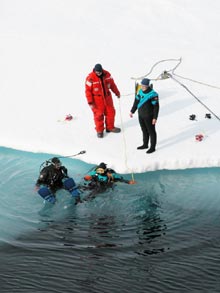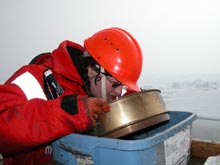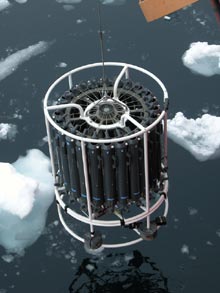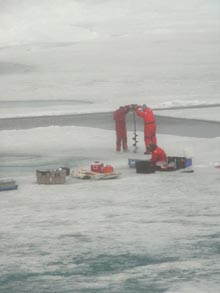
Ice Divers Katrin Iken (left) and Shawn Harper (right) enter the water while Coast Guard Petty Officer Louis Bishop tends the line and Elisabeth Calvert stands by as the safety diver. Click image for larger view.
Scientific Operations Have Begun!
June 28, 2005
Kelley Elliott
Web Coordinator
NOAA Office of Ocean Exploration
The first days of a scientific expedition are spent setting up and testing equipment, and may be riddled with operational problems. After bypassing planned station one, we arrive at station 2 and begin the first round of scientific operations. Each day a plan outlining the schedule of daily operations is posted on the "board of lies," a white board in the main scientific lab so named because operations regularly do not go as planned.
Ice Divers are the first to go early in the morning. A crane lowers a small coast guard boat over the side, carrying the ice divers and supporting Healy crew away from the boat onto the ice edge. Two anchors are set in the ice instead of the ocean floor 700 meters below, to secure the boat before divers step off with their gear. Divers gear up and enter 30 o F water from the ice edge. One diver holds onto a line lowered by a support person on the surface for safety reasons, while the second diver is connected to the first by a tether. The divers descends under ice varying from one to ten meters thick to sample amphipods, take pictures, and shoot video used to characterize habitats and ice bottom structure. While under the ice, divers and surface support communicate by giving a series of tugs on the line.
Back on the ship, the "live net," a fine mesh net with a wide opening and a 30 liter "cod-end" (plastic bucket), is deployed by Russ Hopcroft. The net is set into the water with its cod-end pulled downward by a 50 pound weight, and its mouth connected to the boat by a cable. As the net moves up through the water column capturing zooplankton, the wide container at the end of the net reduces turbulence inside the net, and ultimately damage to the animals captured. Animals captured are studied and photographed to determine the variety of species in the water column.
A Conductivity Temperature Depth (CTD) cast connected to a rosette full of water sampling containers is deployed next. A thick wire connects the cast to an A-frame on the starboard (right) side of the vessel before it is lifted and slowly lowered over the side into the icy waters below. The CTD attached to the rosette will collect information on the salinity, temperature, chlorophyll and dissolved oxygen content of the water at different depths during the dive. Each sampling container in the rosette is given a number connected to an electronic board on top. Scientists receive information including depth from the cast as it dives deep into the ocean and remotely close each sampling container at pre-determined depths. When the CTD/rosette cast is brought back up the surface, multiple scientists will use the samples for different types of analysis.
Out next are members of the Sea-Ice team to conduct various operations. The scientists meet on the helicopter deck for their ride to the ice below: a "man lift" raised and lowered by a crane on the port (left) side of the vessel. The "man lift" is a platform with four beams and a single chain or beam across each side to keep you from falling out, providing a transport experience meant only for the brave.
Once on the ice, the scientists set up their stations and tests begin. The sea-ice team has brought a variety of equipment out with them, including an ice auger to drill big holes, and an ice corer to take samples of the ice. Sue Moore, a marine mammal expert, dips an omni-directional hydrophone in the water to listen for whales and seals. Rolf Gradinger and team dip plankton nets through a hole in the ice and gather ice core samples to study the primary production of algae living in the ice.
Terry Whitledge and team drill a hole through the ice before measuring light under the ice using an electronic light meter. The team categorizes the amount of light penetrating the water, and collects water samples to test nutrients and chlorophyll. Distinguishable nutrients are added before lowering each sample back into the water. Additional data is collected as the team deploys a CTD through the ice. The information gathered from these instruments and samples will be used to describe rates of plant growth in under ice communities, a topic not well understood.

Scientist Brenda Holladay takes a close look at benthic organisms in a sieve. Click image for larger view.
While ice operations are ongoing, the benthic team deploys box cores to take samples of organisms living in the muddy seafloor 700 meters below. The box core is lowered to the seafloor, slowing when approaching the bottom so as not to disturb the mud, and is set down to take a "cookie cutter" sample of the seafloor. As the core is brought back up, a mechanism releases the "bottom" of the box, sealing it for the ride back up. Once the sample is brought on board, the benthic team, led by Bodil Bluhm, place small amounts of the mud in a sieve and rinse the sample with water until the organisms living in the mud are revealed for additional study.
The ROV team is busy preparing the ROV for operations. Some tools are being reconnected to the ROV since they were removed for transport from Massachusetts weeks ago. The high definition video camera, 3 operational cameras, 6 rotors, and digital still camera on board are being wired for control and communication. Fiber-optic cables are being installed and connected to the surface to communicate with ROV and view the camera footage. Preparations continue and the ROV likely will not be deployed for another day.
Sign up for the Ocean Explorer E-mail Update List.


































